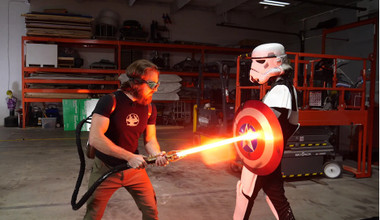How Close Are We to Real Plasma Weapons?
Posted by Korbanth Sabers on Sep 9th 2025
The Science Behind Lightsabers
For generations, science fiction has captivated audiences with visions of energy weapons that transcend the limitations of conventional firearms and bladed combat. From the phasers of Star Trek to the plasma rifles of alien battlefields, these luminous instruments of power have sparked our collective imagination and transported us to worlds where technology borders on magic.
Yet among all the energy weapons that have graced our screens, none has achieved the iconic status of the lightsaber. More than just a weapon, the lightsaber represents the perfect fusion of ancient warrior philosophy and futuristic technology. Its elegant hum, the way it cuts through blast doors like butter, and those unforgettable duels that blur the line between combat and dance—these elements have made the lightsaber the undisputed champion of fictional weaponry.
What makes the lightsaber so mesmerizing isn't just its devastating effectiveness in the hands of a Jedi or Sith. It's the tantalizing possibility that such a device could actually exist. Unlike faster-than-light travel or telepathic powers, a contained beam of superheated plasma feels within the realm of scientific possibility. The lightsaber doesn't just mystify us with its otherworldly glow—it opens our minds to question what might be achievable with the right breakthrough in plasma physics and magnetic containment.
Every time we watch that iconic blade ignite with its distinctive snap-hiss, we can't help but wonder: are we witnessing pure fantasy, or a glimpse into humanity's technological future? How far away are we from creating real lightsabers?

The Heart of the Blade: Understanding Plasma
To understand how close we are to real lightsabers, we first need to examine what would actually create that brilliant, cutting beam. In the Star Wars universe, lightsabers generate their legendary blades through superheated plasma—the same state of matter that powers the sun and other stars. Plasma, often called the fourth state of matter, forms when gas becomes so hot that electrons separate from their atoms, creating a glowing soup of charged particles.
This isn't just science fiction speculation. Real plasma reaches temperatures of thousands or even millions of degrees, hot enough to slice through virtually any material we know. In laboratories around the world, researchers routinely create plasma for fusion energy experiments, reaching temperatures that dwarf the surface of the sun. So the raw destructive power of a lightsaber blade? That part is absolutely achievable.
But here's where the dream meets cold, hard physics: plasma has one major problem that makes lightsaber construction incredibly challenging. Unlike the solid steel of a sword or even the focused photons of a laser, plasma is essentially a superheated gas—and gases don't naturally form neat, blade-shaped columns that extend exactly three feet from a hilt and then stop.
Plasma wants to expand. It wants to dissipate. It wants to follow the path of least resistance and spread out in all directions, much like smoke from a fire or steam from boiling water. Without some form of containment, any plasma "blade" would immediately balloon outward, creating more of a superheated cloud than the precise, controlled beam we see wielded by Jedi and Sith. This fundamental challenge—how do you force something that naturally wants to spread out into a specific shape—is the first major hurdle any real-world lightsaber must overcome.
The Power of Magnetic Containment
Fortunately, scientists have already developed a solution to the plasma containment problem: magnetic fields. Magnetic Confinement Fusion (MCF) uses powerful electromagnets to trap and control plasma by manipulating the charged particles within it. Since plasma consists of ions and electrons—all carrying electrical charges—these particles respond to magnetic forces, allowing researchers to guide and contain the superheated gas in specific patterns.
The principle is elegant: by creating precisely controlled magnetic field geometries, scientists can essentially build invisible walls that keep plasma confined to desired shapes and locations. In theory, this same technology could be used to contain plasma in a blade-like configuration, creating the controlled, stable beam that defines a lightsaber. The magnetic fields would act like an invisible sheath, holding the plasma in a sword-like form while preventing it from expanding outward.
But here's the crushing reality check: the scale required for current magnetic confinement technology is absolutely massive. The ITER project in France—scheduled to begin operations in 2034—represents the pinnacle of magnetic confinement fusion research. This facility will use superconducting magnets weighing hundreds of tons, generating magnetic fields up to 100,000 times stronger than Earth's magnetic field, all housed within a building complex the size of 60 soccer fields.
ITER's plasma chamber alone stands six stories tall and weighs as much as three Eiffel Towers. The entire facility requires the electrical output equivalent of a small city just to power its magnetic containment systems. While ITER proves that magnetic confinement can work, it also illustrates just how far we are from miniaturizing this technology into something that could fit in the palm of your hand, let alone be wielded as an elegant weapon for a more civilized age.

The Hacksmith Approach: Engineering Ingenuity Meets Star Wars Magic
We're huge fans of the incredible work that the Hacksmith team has been doing over the years. Their YouTube channel has become a beacon of real-world engineering applied to fictional concepts, and nowhere is this more evident than in their ongoing lightsaber development project. While the rest of us debate the theoretical physics, the Hacksmith team rolled up their sleeves and started building.
Rather than waiting for breakthroughs in miniaturized magnetic confinement, the Hacksmith has taken a brilliantly practical approach to creating functional "protosabers." They focused on integrating a high-power plasma torch with a retractable mechanism to mimic the functionality of a lightsaber, essentially reimagining what a lightsaber could be within the constraints of current technology.
Their evolution through multiple protosaber versions has been fascinating to watch. Their latest designs can reach temperatures over 2500 degrees Fahrenheit using resistive heating, with electricity flowing through titanium and tungsten components to create a red-hot blade. Even more impressive, by adding different salts to the plasma, they can change the beam's color—boric acid creates a green beam like Yoda's lightsaber, sodium chloride produces bright yellow like Rey's, and strontium chloride generates bright red for those who prefer the dark side.
What makes the Hacksmith's approach so compelling is their commitment to creating something that actually works, even if it requires compromises. Their Mini-Saber products feature adjustable 4"-6" flames that can light fires, melt through soda cans, or even help you crème brûlée your favorite dessert. While these aren't the meter-long blades we see in the films, they represent genuine engineering solutions that bring us closer to the dream of wielding real energy weapons.
The Reality Check: Why We're Still Decades Away
While the Hacksmith has made remarkable progress with their practical approach, the dream of a true movie-accurate lightsaber remains frustratingly distant. Even with the massive resources available to government research programs, progress has been disappointing. According to a 2024 Congressional report on defense and intelligence, although the United States has been researching directed energy since the 1960s, experts have observed that the Department of Defense has invested billions of dollars in directed energy programs that failed to reach maturity and were ultimately cancelled.
This sobering reality check puts our lightsaber dreams into perspective. If decades of research and billions in funding by the world's most advanced military-industrial complex haven't produced viable handheld plasma weapons, it's clear that we're still decades—if not longer—away from wielding a genuine lightsaber.
The fundamental challenges remain as daunting as ever: miniaturizing magnetic containment systems, creating portable power sources capable of sustaining plasma generation, and solving the basic physics of containing superheated gas in a blade-like form. While we've made incredible strides in understanding plasma physics and magnetic fields, the engineering leap required to compress building-sized technology into a handheld weapon represents a challenge that may require revolutionary breakthroughs we can't yet imagine.
So until that distant day when someone cracks the code of portable plasma containment, you might as well embrace the next best thing. At Korbanth Sabers, we've dedicated ourselves to creating the most movie-accurate, beautifully crafted lightsaber replicas available. While they may not cut through blast doors or deflect blaster bolts, our sabers capture every detail, sound, and lighting effect that made you fall in love with these elegant weapons in the first place.
Because sometimes, the most realistic approach to owning a lightsaber is accepting that the closest we can get—for now—is a masterpiece of craftsmanship that honors the legend while we wait for science to catch up to science fiction. Visit korbanth.com/sabers and bring home your piece of the galaxy far, far away.

